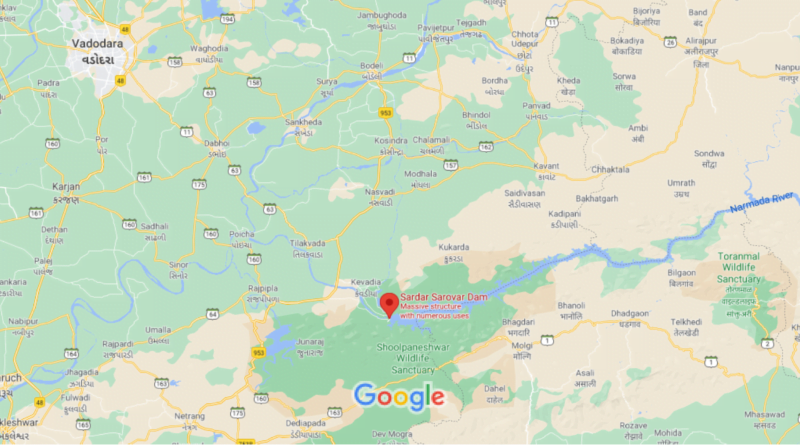Sardar Sarovar Dam
About Sardar Sarovar Dam
- The Sardar Sarovar Dam is a concrete gravity dam built on the Narmada river in Gujarat.
- Four Indian states, Gujarat, Madhya Pradesh, Maharashtra and Rajasthan, receive water and electricity supply from the dam.
- The foundation stone of the project was laid out by Prime Minister Jawaharlal Nehru on 5 April 1961.
- The project took form in 1979 as part of a development scheme funded by the World Bank through their International Bank for Reconstruction and Development, to increase irrigation and produce hydroelectricity
- The construction for dam begun in 1987, but the project was stalled by the Supreme Court of India in 1995 in the backdrop of Narmada Bachao Andolan over concerns of displacement of people.
- In 2000–01 the project was revived but with a lower height of 111 metres under directions from SC, which was later increased in 2006 to 123 metres and 139 metres in 2017.
- The dam was inaugurated in 2017 by Prime minister Narendra Modi. The water level in the Sardar Sarovar Dam at Kevadia in Narmada district reached its highest capacity at 138.7 metres on 15 September 2019.
- Sardar Sarovar Dam (SSD) is the largest structure to be built. It is the second largest concrete dam in the world in terms of the volume of concrete used in its construction, after the Grand Coulee dam across River Columbia, US.
Benefits of the Project
- Unused Water from Narmada river, which would otherwise flow into the sea, is used for serving many dry towns, villages and districts of Gujarat.
- The project employed about one million people starting from the start to the end of the Sardar Sarovar project.
- Provided electricity to the unserved regions and also to the farmers.
- Provided water for irrigation and for drinking purposes.
- Around 800,000 hectares of land in Gujarat and approx 2,46,000 hectares of land in Rajasthan are irrigated by the water of SSD. It is said that it provides drinking water to 131 towns and cities and around 9,633 villages in the four states, mostly the drought-prone areas of Kutch and Saurashtra.
- Provided flood protection to an area of about 30,000 hectares which is prone to the fury of floods.
- Wildlife sanctuaries will also be benefited
What are the controversies?
- Impact – Full reservoir capacity will cover 40,000 hectare and hence expels 244 villages and one township.
- About 10 lakh people involved in diverse economic activities would have to be displaced.
- Vast tracts of forest stare submergence.
- Prime agriculture land and at least a few thousand cattle in each village will be lost.
- NBA – “Narmada Bachao Andolan” an NGO started an intense campaign against it.
- It elaborately documented the economic damages and the plight of the displaced.
- Its research on the environment & ecological implications of the project even won the applause of the apex court.
- Court Rulings – While the project wasn’t stayed, Supreme court passed orders to address the greviences of the displaced.
- A Grievance Redressal Authority (GRA) was step up to receive complaints and pass directions to the state authority.
- Those entitled to land were sanctioned Rs.60 lakh compensation.
- SC also directed that all amenities, mandatory under law, should be in place at resettlement sites by June 2017 – an enormous task.
List of Hydroelectric Power Plants in India
| States | River | Hydroelectric Power Plant |
| Andhra Pradesh | Krishna | Nagarjunasagar Hydro Electric Power plant |
| Andhra Pradesh | Krishna | Srisailam Hydro Electric Power plant |
| Andhra Pradesh, Orissa | Machkund | Machkund Hydro Electric Power plant |
| Gujarat | Narmada | Sardar Sarovar Hydro Electric Power plant |
| Himachal Pradesh | Baira | Baira-Siul Hydroelectric Power plant |
| Himachal Pradesh | Sutlej | Bhakra Nangal Hydroelectric Power plant |
| Himachal Pradesh | Beas | Dehar Hydroelectric Power plant |
| Himachal Pradesh | Sutlej | Nathpa Jhakri Hydroelectric Power plant |
| Jammu and Kashmir | Chenab | Salal Hydro Electric Power plant |
| Jammu and Kashmir | Jhelum | Uri Hydro Electric Power plant |
| Jharkhand | Subarnarekha | Subarnarekha Hydroelectric Power plant |
| Karnataka | Kalinadi | Kalinadi Hydro Electric Power plant |
| Karnataka | Sharavathi | Sharavathi Hydroelectric Power plant |
| Karnataka | Kaveri | Shivanasamudra Hydroelectric Power plant |
| Kerala | Periyar | Idukki Hydro Electric Power plant |
| Madhya Pradesh | Sone | Bansagar Hydroelectric Power plant |
| Madhya Pradesh | Narmada | Indira Sagar Hydro Electric Power plant |
| Madhya Pradesh, Uttar Pradesh | Rihand | Rihand Hydroelectric Power plant |
| Maharashtra | Koyna | Koyna Hydroelectric Power plant |
| Manipur | Leimtak | Loktak Hydro Electric Power plant |
| Odisha | Sileru | Balimela Hydro Electric Power plant |
| Odisha | Mahanadi | Hirakud Hydro Electric Power plant |
| Sikkim | Rangit | Rangit Hydroelectric Power plant |
| Sikkim | Teesta | Teesta Hydro Electric Power plant |
| Uttarakhand | Bhagirathi | Tehri Hydro Electric Power plant |
| Himachal Pradesh | Baspa | Baspa-II Hydro Electric Power plant |
| Himachal Pradesh | Satluj | Nathpa Jhakri Hydro Electric Power Plant |
| Himachal Pradesh | Beas | Pandoh Dam |
| Himachal Pradesh | Ravi | Chamera-I |
| Himachal Pradesh | Ravi | Chamera-II |
| Himachal Pradesh | Beas | Pong |
| Jammu and Kashmir | Chenab | Dulhasti |
Narmada Bachao Andolan
Discover more from Simplified UPSC
Subscribe to get the latest posts sent to your email.



